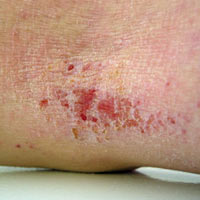Eczema Rash
The eczema rash is one of the most distinctive features of eczema, despite the fact that its appearance will vary from person to person. Everyone with eczema will have a rash … and an itch. The typical eczema rash is dry, red, scaly and itchy. The skin is always inflamed.
Baby eczema oozes and crusts
Although born with a predisposition to develop eczema it is rare for the condition to develop before the age of 2 months. The eczema rash, which usually appears on the skin of a baby developing eczema between the ages of 2 – 4 months, will typically be red and inflamed with oozing and crusting.
A child not developing eczema until the age of 2 years will generally find that the eczema rash is drier and more scaly. Despite the differences in the presentation of the rash the eczema rash is still quite easy to identify and fortunately for most children their eczema and the rash will be outgrown by the time they start school.
The rash is dry, red and scaly

For some the eczema continues on into the teens and adulthood. Eczema at this age is typically characterized by dry, red skin that is scaly and inflamed. The itch is always present resulting in the presence of numerous scratch marks covering the rash and in some cases the skin over the eczema rash will become broken and possibly infected.
Eczema developing in adulthood is often quite different in appearance to that of the eczema rash found in children. And the location of the rash is often more confined. Whilst children will often find the eczema rash appears mainly on the face and behind the knees and elbows, adults will be more prone to develop eczema on the hands or sometimes in patches on the lower leg.
Of course this is a generalization and the eczema rash can cover any part of the body at any age and the severity of the rash will vary from person to person.
Adult eczema often affects the hands – look out for the rash
The most common form of eczema experienced by children is atopic eczema. Whilst adults can also develop atopic eczema contact dermatitis of the hands is more common. Here the eczema rash will appear in response to the hands coming in contact with something they are sensitive to.
Another form of eczema common amongst older adults is nummular eczema. Here the eczema rash presents as small, red, coin shaped lesions usually on the legs. As the rash heals it develops an appearance not unlike ringworm.
Regardless of the appearance of the eczema rash or the type of eczema experienced it is important to take care of the affected skin and remember to keep it well moisturized at all times. Consult your doctor if your eczema rash takes on a different appearance of if you are having difficulty controlling it.
Mel Sinclair, RN
